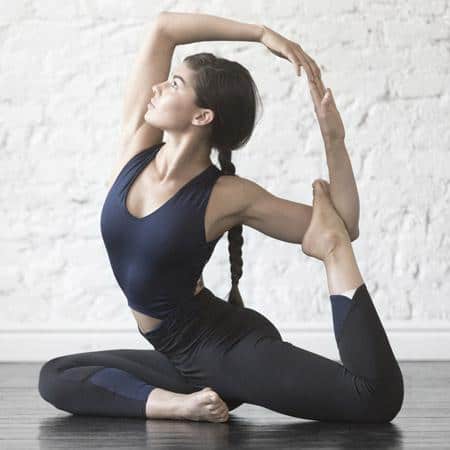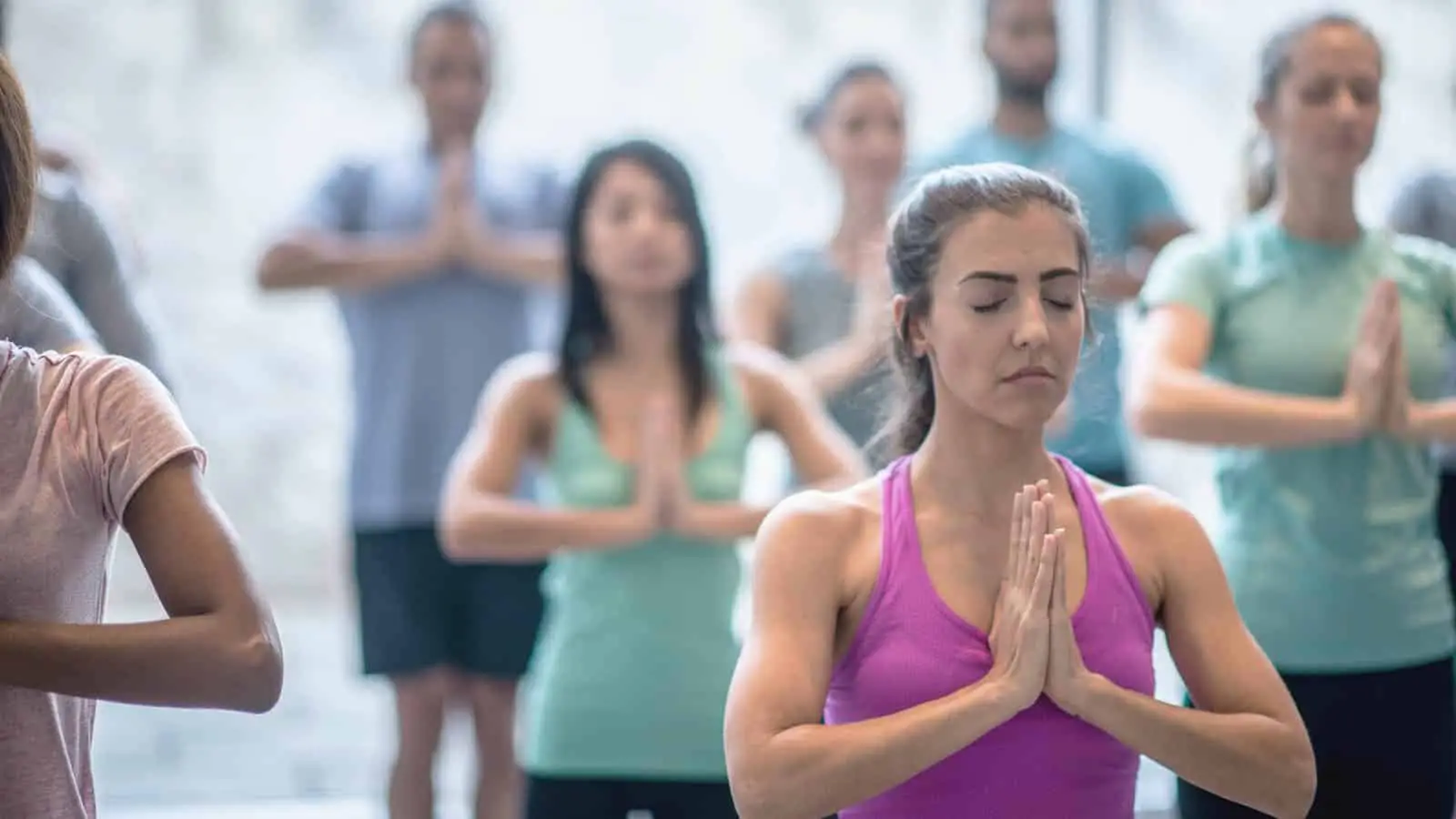You’re excited about getting to your yoga class and realize you’re running a little late.
Forgetting about yoga class etiquette, you arrive at the studio just as the class is starting. You run inside, check-in, kick off your shoes, and make your way into the class that has already begun. You roll out your mat and grab a few yoga props while the teacher is holding space and instructing the students to focus on their breath. You finally come to stillness in Mountain Pose, and you’re ready to begin your practice. This may seem like a typical scenario when attending a yoga class, but rewind the tape to consider the etiquette around going to a yoga class.
Just as being on the yoga mat is a mindful experience, so should the arrival and departure from your class.
Yoga class etiquette: Arriving: On-Time or Late
Ideally, it would be a good idea to arrive early for your yoga class so that you can get fully prepared for the practice ahead. If you’re able, arrive 10 to 15 minutes early. This will give you time to park, enter the studio, get checked in, pay, remove your shoes, change your clothes, and step into the studio space. Once inside, you can roll out your yoga mat, grab any props you may need for your practice, then have time to sit and meditate before the class officially starts.
Having these few extra minutes to sit and fully arrive is a wonderful way to experience presence when the instructor eventually begins the lesson.
However, sometimes you are running a little late and may not have time to prepare for class properly. What should you do if the class has already started when you’re ready to enter the room?
If your instructor happens to have a specific way that he/she begins class, then it may be polite to wait outside or just inside the door until that portion of the class is complete. For example, your teacher may start the class with an incantation, a chant, a meditation, or a song that sets the mood and intention of the yoga session. It would be an interruption if you walked into the quiet studio at this moment to set up your mat. It may distract the teacher as well as the other students who are in deep focus. If you step inside as the teacher is offering the meditative intention, patiently stand in stillness. Refrain from strolling around the room looking for a space or rolling out your mat. Once the class begins moving, then proceed to enter the classroom.
All in all, you want to be mindful and respectful of the teacher and students if you happen to arrive to class late.
Some studios have a policy about late arrivals. For example, if you are more than 10 minutes late or if the class is full, you may not be allowed to enter the class. Please respect these policies that have been designed to offer everyone at the studio a positive experience.
Yoga class etiquette: Turn it Off, Please

We certainly live in an age where just about everyone carries a cell phone. It allows us to be in constant contact with the outside world at all times. Remember, though, why you are going to a yoga class. One intention is to leave your responsibilities at bay temporarily. Attending a yoga class is an opportunity to take care of yourself without any distractions. That means turning off your cell phone when you come to class. (Or at least turn it on vibrate if you’re expecting an urgent call or message.) It’s always a good idea to inform your teacher before class that you may need to leave your cell phone on vibrate due to a work or family issue. If you receive an alert, discretely step outside the classroom to take your message.
Nothing is more inappropriate than checking your phone during a yoga class: texting, checking emails, or answering the phone. (Yes! It happens!) Do the proper thing and turn off the phone or store it outside of the classroom with your other belongings, so you’re not tempted to check it.
Yoga class etiquette: Wardrobe
If you arrive at the studio wearing layers over your yoga clothes, be sure to hang up your coats, scarves, and hats before going into the classroom. It goes without saying that you should take off your shoes, too. What should you do with personal items like purses and bags? For your personal safety, you may not want to leave your valuables in the car. Be sure to bring them inside. Some studios may allow you to bring a purse or other valuable items directly into the yoga classroom, providing there is space. Otherwise, leave them in the areas provided outside the classroom. Some studios have lockers that you can use to store your personal items. It might be a good idea to bring a combination lock to secure your belongings. If you’re practicing yoga at a gym, you can certainly keep your personal property in a locker.

Your yoga attire is also something to pay attention to. Depending on the style of yoga, you want to dress appropriately. For meditation, Yin Yoga, or other restorative practices, you want to wear comfortable clothing that you can easily move in and certainly relax without the distraction of binding or pinching outerwear. For faster-moving and more dynamic yoga classes like Power Vinyasa Yoga or Hot Yoga , you may prefer wearing minimal clothing.
How little is too little? For gentlemen, going shirtless to such yoga classes is appropriate in most cases. Just be sure to be modest when it comes to yoga shorts. Keep everything well contained. Ladies, it’s important that you practice modesty, too, when you practice. Sports bras should fit appropriately if you want to be more minimal in your attire. Wear shorts or yoga pants that are opaque and fit comfortably for ease of movement. For all yogis, this is not a fashion show.
You are not in competition with other yogis to see who has the best outfit. Yoga is a personal practice and should be about your individual path. How you look shouldn’t be your first concern.
Yes, you certainly want to be able to move easily in class, but be sure that you take your fellow yogis into account. You don’t want to offend anyone.
Yoga class etiquette: Have to Leave Early?

If you know that you have to leave the class early, inform your teacher. This would be a respectful gesture. You may be encouraged to set up your yoga space near an exit door so that you can leave discretely. The teacher may also advise you to take a personal Savasana posture before leaving the class to help conclude your practice. Further, if any props were used, leave them on the floor; no need to put them away if this disturbs the flow of the class. The instructor can return the props to their proper location after class.
Once a class has come to a close with the final Namaste, take a moment before jumping off your mat. Embody your yoga experience, move slowly as you’re preparing to leave. Others around may want to sit in meditation before leaving the classroom; be respectful of their space. A hurried and flustered movement from you may be a disturbance to others. Take your time; move with ease and grace so that the yoga intention remains contained even though the class has ended.
Store your used props, roll up your mat, and save conversations with friends until after you have left the sacred space. Socialize outside the classroom.
Conclusion
Everyone wants to have a good experience when they go to a yoga class. Being aware of the above practices are considered proper yoga etiquette. Treat the whole experience as a respected ritual: your arrival, your practice, and your departure. Be mindful of yourself, your fellow yogis, and your instructor. It will make your practice (and theirs) wonderfully positive and pleasant.








